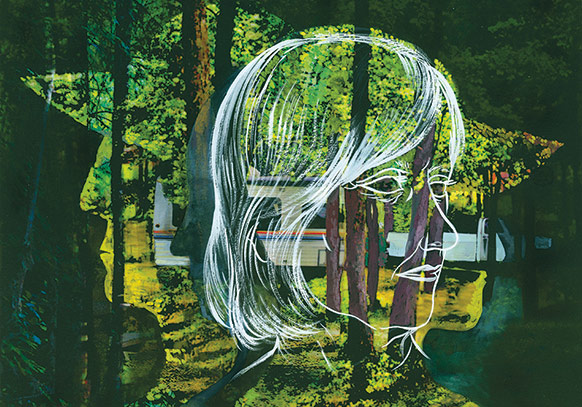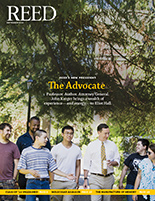
IRIS login | Reed College home Volume 91, No. 3: September 2012
The Darkness of Memory Lane

Illustration by Katherine Guillen
Professor Daniel Reisberg’s expertise on perception and memory is having an impact far beyond the classroom.
By Bill Donahue
It was dark outside when she was shot. Ten at night, roughly. The gunman stood outside her camper in Oregon’s Umpqua National Forest on that August night in 2003 and nailed her in the chest as she reached to close the window. Sherl Hilde, age 45, crumpled, unable to move her legs. A few moments later, the attacker shot her husband, Noris Hilde, as he called 9-1-1 on her cell phone.
Noris died, but Sherl survived. Bleeding profusely, she was flown by helicopter to the hospital, where she recuperated for a month. Meanwhile, local detectives developed a theory. The killer, they believed, was troubled 28-year-old Samuel Adam Lawson, who had recently stolen a .357 Marlin rifle from his father’s gun case. Lawson had met the Hildes hours before the killing, when the couple drove up to their reserved campsite, only to find it occupied—by Lawson, who gathered his gear and shuffled away.
Two years later, at a pretrial hearing, Sherl Hilde pointed at Samuel Lawson and proclaimed, “I’ll never forget his face as long as I live.”
Lawson was ultimately convicted of aggravated murder and is now serving a life sentence in the Oregon State Penitentiary. But there is a problem with this case. The most compelling evidence against Lawson lies in the memory of Sherl Hilde, and there is reason to think that her memory may be wrong.
Professor Daniel Reisberg [psychology 1986–] is an authority on cognition and on the complex ways in which people remember—and sometimes fail to remember—the details of their lives, including the traumatic moments they have experienced. The author of scores of articles and a dozen books, he is a leading expert on eyewitness IDs. He has testified for the defense in many trials in Oregon, Washington, and Idaho, some of them involving murder or sex abuse. At Lawson’s 2005 trial, he held the witness stand for a full day and declared, “I honestly cannot think of a single case I have ever seen or heard about that had this many concerns about one or another factor that could compromise somebody’s capacity to remember.”
The problems in the Lawson case began within minutes of the shooting. As the helicopter flew her to the hospital, Hilde was certain who the killer was. She fingered, of all people, the pilot. Initially, she told police that she never saw the shooter. Shown a photo throwdown, she did not pick out Lawson. Over time, however, as investigators attempted to reconstruct the shooting, her memory began to evolve. She recalled that the shooter had shoved a chair cushion over her eyes to prevent her from seeing him, but that she caught a glimpse of him in profile. After she had seen Lawson’s photo on half a dozen occasions, the memory of that glimpse became clearer and clearer, until finally she was certain that Lawson was the killer.
Professor Reisberg’s testimony didn’t persuade the jury, but Lawson’s attorneys [who include Laura Graser ’73] appealed his conviction to the Oregon Supreme Court, which will likely rule some time this year. [Coincidentally, Reedies Bronson James ’94 and Bear Wilner-Nugent ’95 have both filed briefs on behalf of amici curiae.] Even if it refuses to grant a retrial, it could update the way Oregon courts handle eyewitness IDs garnered by investigators using suggestive tactics—in other words, by inadvertently leading the witness into fingering the prime suspect.
Oregon’s standard for reconstructed IDs was set in 1979, in State v. Classen, when the Oregon Supreme Court (in an opinion written by Justice Hans Linde ’47) ruled that such IDs could be shared with juries, but only if they stood a reasonable chance of being reliable. The court cited several factors that judges could weigh in allowing such IDs to be admitted as evidence—did the witness get a good view of the alleged criminal? Was he or she certain that the ID was accurate?
The Classen rules (and the federal rules on which they are based) were never perfect, but in recent decades grave doubts have begun to sprout around them. In fact, the New York–based Innocence Project reckons that eyewitness misidentification is the single greatest cause of wrongful convictions nationwide. Since 1989, nearly 300 U.S. prisoners have been exonerated by DNA evidence; about 75% of them had been mistakenly sent to prison because of faulty eyewitness evidence.
The 180-page transcript of Reisberg’s testimony explains why an honest eyewitness might make a faulty ID. Exuding at turns both the drama of Stephen King and the explanatory tone of a psychology textbook, Reisberg’s narration dwells, at first, on a white North Carolina woman, Jennifer Thompson, who was raped in 1984. Police suspected a black man, Ronald Cotton. Thompson picked Cotton out of a lineup, and the officer told her she’d done a “good job.” Cotton was duly convicted and imprisoned for 11 years—until DNA evidence conclusively proved him innocent. Thompson had identified the wrong man. Still, the effect of the cops’ certainty was so powerful, Reisberg told jurors, “that even after Jennifer was shown irrefutable [DNA] evidence that they had the wrong guy, she has testified that when she plays the videotape in her head of that awful night, the face she still sees is Cotton’s.” [Since then, Jennifer Thompson has become an outspoken advocate for eyewitness reform. Miraculously, she and Cotton have become friends, and have made several joint appearances. She no longer sees Cotton’s face in her mental video.]
Moving to the particulars of the Lawson case, Reisberg cast doubt on whether Sherl Hilde—shot in the dark, and then bleeding, traumatized, and heavily medicated—ever had the wherewithal to consolidate a vivid memory of the crime. He noted that, inside the brains of trauma victims, glucocorticoids work overtime. They manage stress but also, Reisberg noted, shut down memory consolidation. “It’s like never putting the book on the bookshelf,” Reisberg said. “You’re not going to be able to find it later.”
Reisberg also discussed a study in which researchers successfully planted memories in subjects by showing them a movie of a car driving through a quiet countryside devoid of manmade structures and then asking, “Can you tell me how fast was that car going when it went past the barn?” The subjects then remembered the fictional barn. Reisberg suggests that by repeatedly showing Hilde Lawson’s photograph, the police planted a memory in her mind. “Eventually,” he said, “you’re going to look at that photo and say, boy, that’s familiar.”
Reisberg was playing to a tough audience (rural, conservative Douglas County is among the most pro–death penalty jurisdictions in Oregon), but he is a nimble and animated performer—bouncy on his feet, his hands a flurry of emphatic gestures, and his voice rises to an excitable trill as he drives home his points. Students at Reed, where he’s been teaching since 1986, gave him an award last year for being the “most likely to jump on his desk.” In court, he explained the most abstruse psychological studies in everyday terms (by, for instance, telling a story about a bickering couple), and in the right moments he was not above humor. Consider this discussion of leading questions seven or so hours into Reisberg’s testimony:
Prosecutor: You want to go home pretty quick, right? Leading question?
Reisberg: “Pretty quick” isn’t essential, but I’d love to be in Portland before dark.
Judge: When does it get dark in Portland? And how fast do you drive?
Reisberg: Legally, Your Honor.
Judge: Of course.
Reisberg: That was a leading question.


LATEST COMMENTS
steve-jobs-1976 I knew Steve Jobs when he was on the second floor of Quincy. (Fall...
Utnapishtim - 2 weeks ago
Prof. Mason Drukman [political science 1964–70] This is gold, pure gold. God bless, Prof. Drukman.
puredog - 1 month ago
virginia-davis-1965 Such a good friend & compatriot in the day of Satyricon...
czarchasm - 4 months ago
John Peara Baba 1990 John died of a broken heart from losing his mom and then his...
kodachrome - 7 months ago
Carol Sawyer 1962 Who wrote this obit? I'm writing something about Carol Sawyer...
MsLaurie Pepper - 8 months ago
William W. Wissman MAT 1969 ...and THREE sisters. Sabra, the oldest, Mary, the middle, and...
riclf - 10 months ago